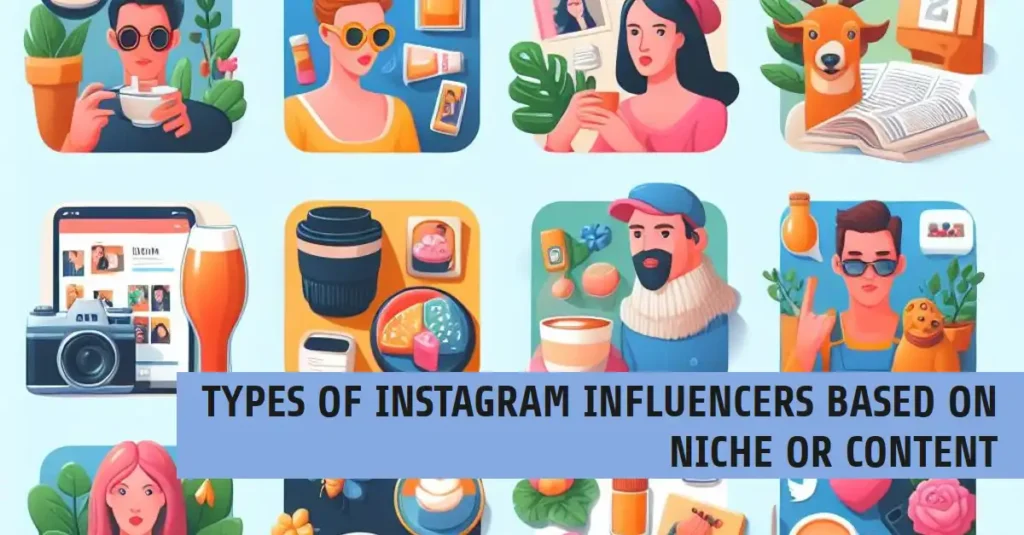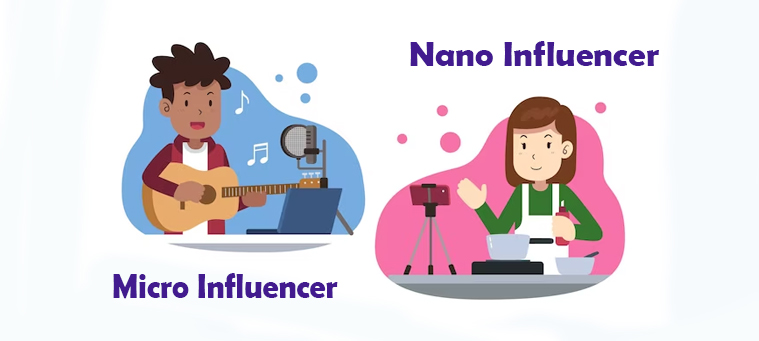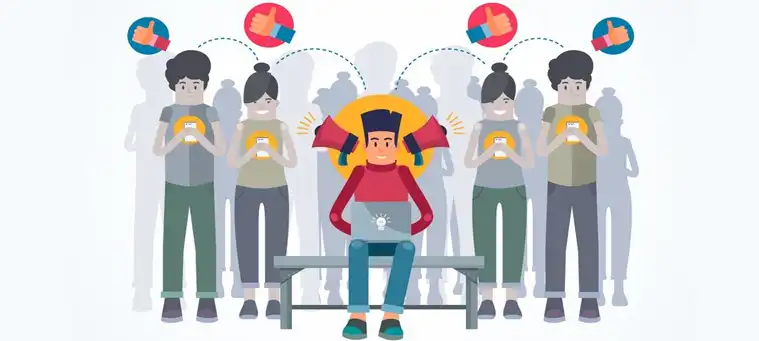Sup Guys! I’m gonna be real with ya – influencing seems like easy money if you can blow up on Instagram! But turns out there are different types based on the following, and who you work with. Mega ones like Kylie Jenner have a wild 377 million followers! Down to nano folks talking bout their pet dachshund to like 100 fans all heart-eyed over poppers! I’ll break it down for ya’ll today on the main kinds of influencers jumpin’ on Insta Game. Read on to see who could make bank or maybe…be your new BFF!

Types of Instagram Influencers Based on Follower Count

Instagram has given rise to a new type of internet celebrity and opinion leader: influencers who leverage the platform’s viral potential to build audiences and profit. From mega-celebs with follower counts rivaling small countries to micro-influencers crafting content around niche passions, there exists an influencer at every level of reach. When developing an influencer marketing strategy, brands must consider their campaign goals, target demographic, and budget to determine which tier of influencer provides the ideal fit.
Mega-Influencers
Mega-influencers are the highest tier of influencers. They have over 1 million followers on Instagram and often have celebrity status and worldwide fame. Mega-influencers can drive awareness of brands to a very large audience. However, their sponsored content can be very expensive for brands.
Example
Niche: Beauty & Business
Huda Kattan (@hudabeauty): With 54.1 million followers, Huda is a makeup mogul and influencer known for her innovative beauty products and tutorials. Her engaging content featuring product reviews, makeup tips, and glimpses into her life attracts a wide audience.

Pros and Cons of Working with Mega Influencers
| Pros | Cons |
| Massive reach (over 1 million followers) | Very expensive (over $100K per post) |
| High brand awareness & visibility | Risk of PR crises or scandals |
| Celebrity status draws attention | Content can feel distant or inauthentic |
Mega-influencer partnerships are often chosen for large national or global ad campaigns with sufficient budgets, as they can maximize brand exposure with viral content that taps into celebrity appeal. They can drive immediate awareness of a new product launch or public relations push, though there are risks associated with hitching a brand’s reputation to a famous name that may catch negative headlines.
Macro-Influencers
Macro-influencers typically have between 100,000 to 1 million Instagram followers. They have a sizable following and are viewed as having expertise or credibility in their niche. Macro-influencers often focus their personal branding around lifestyle topics like fitness, travel, fashion, beauty, and more. Their high engagement and niche audience allows them to charge brands thousands of dollars for sponsored posts.
Example
Niche: Fashion
Amy Jackson (@fashion_jackson): 3.4M+ followers. Style & lifestyle maven showcasing chic outfits, travel diaries, beauty collabs, and glimpses into her aspirational world. A leading fashion influencer inspiring millions with her trendsetting choices and building a successful brand through social media.

Pros and Cons
| Pros | Cons |
| Broad audience reach (100K-1M followers) | Less reach than mega (1M+) |
| More affordable than mega (thousands per post) | Still moderately costly |
| Perceived as experts in their niche | Harder to stand out in saturated niches |
Macro-influencers offer an appealing middle ground for brands seeking wide reach combined with target niche appeal and the credibility of established social media experts. They can deliver distinct communities and demographics without the astronomical cost of mega celebs, though competition exists within saturated influencer niches. They work well for brands seeking scalable influencer strategies that combine broad awareness and selective engagement.
Micro-Influencers
Micro-influencers have between 10,000 to 100,000 Instagram followers. Compared to mega and macro-influencers, they have a smaller but highly engaged audience. Micro-influencers often post content related to their personal passions, interests, or areas of expertise. Many brands work with micro-influencers as part of their social media marketing strategy because they offer the potential for driving real connections and engagement with target audiences.
Example
Niche: Photography and Makeup
Pastel Mints (@pastelmints): With 29k followers, Geena is a photographer and makeup artist who blends whimsical aesthetics with artistry, showcasing both her talents in one delightful Instagram platform.

Pros and Cons
| Pros | Cons |
| Highly engaged small audience (10K-100K) | Narrow audience appeal |
| Viewed as authentic experts, not celebs | Producing quality content inconsistently |
| Affordable cost compared to macro & mega |
Micro-influencers provide the authentic, niche appeal of everyday experts with sizable but not expansive engaged audiences. They allow even limited marketing budgets to activate targeted influencer partnerships. Micro-influencer content feels genuine, relying on relatability over celebrity spectacle — though content quality varies more without a celebrity team smoothing rough edges. They deliver value for brands seeking granular demographic targeting through accessible, appealed-focused content.
Nano-Influencers
Nano-influencers have less than 10,000 Instagram followers. However, what they lack in follower size they make up for in engagement and connection with their small community. Nano-influencers often have niche audiences they know very well. Brands often work with multiple nano-influencers to increase reach across specific target markets. With their high engagement and low sponsored post costs, nano-influencers can offer value despite their small follower count.
Example
Niche: Baking
@anneshkadesserts: With 7k followers, Anne shares mouthwatering dessert creations and baking tips. Her close-up photos and relatable captions engage a niche audience passionate about sweet treats.

Pros and Cons
| Pros | Cons |
| Strong bonds with tiny niche (<10K) | Very limited reach |
| Cheap sponsored post costs | Unpredictable content quality |
| Highly authentic brand collaborations | Fleeting popularity |
Nano-influencers offer ultra-narrow but deep audience intimacy that resonates within their niche despite lacking reach beyond. For certain brands emphasizing demographic precision over volume, nano-influencers provide low-cost access points into tiny but powerful communities. Their mini-audience also means fickle followings vulnerable to sudden shifts in platform algorithms or trends. However, the bonds nurtured post-to-post between nano-influencers and hyper-targeted niches can produce authentic connections that translate into brand success and loyalty.
Bonus Point
Nano influencers have the highest engagement rate (8.7%), but the lowest cost per post ($100). Mega influencers have the lowest engagement rate (1.6%), but the highest cost per post ($10,000). Micro and macro influencers have moderate engagement rates (3.8% and 2.7%, respectively) and costs per post ($500 and $2,500, respectively).
Types of Instagram Influencers Based on Niche or Content

Beyond follower count, influencers on Instagram can also be categorized according to their niche and content focus which targets specific audiences. From lifestyle topics to creative fields to sports, influencers align themselves with certain subjects, industries, and communities.
Lifestyle
The lifestyle niche on Instagram covers influencers sharing content related to fashion, beauty, travel, fitness, parenting, and more aspects of their personal lives. These influencers showcase products and services relevant to their audience.
Fashion
Fashion influencers create content around clothing, accessories, style tips, outfit ideas, and brand promotions. Examples include Aimee Song (@aimeesong) with 7.3 million followers and Chiara Ferragni (@chiaraferragni) with 29.3 million followers. They often collaborate with fast fashion and luxury brands.
Beauty
Beauty influencers focus on makeup, skincare, hair styling, cosmetics, and beauty-related products. Popular examples include Huda Kattan (@hudabeauty) with 58.5 million followers and Zoe Sugg (@zoesugg) with 9.2 million followers. They frequently promote beauty brands, cosmetics companies, and personal care products.
Travel
Travel influencers share content around destinations, travel tips, photography, reviews, and adventures. Johan Lolos (@lebackpacker) has 390k followers showcasing luxury destinations. Others like Nicol Carreño Adventure (@nicol_adventure) have 26.4k followers sharing adventure destinations and activities. These influencers often get sponsorship opportunities from tourism boards, hotel brands, and travel companies.
Fitness & Wellness
Fitness and wellness influencers provide advice, inspiration, workouts, and healthy recipes, and promote fitness/wellness brands. Kayla Itsines (@kayla_itsines) has 16 million followers with workout plans and Sjana Elise (@sjanaelise) has 1.3 million followers promoting self-care. They collaborate with nutrition brands, fitness gear companies, gyms/studios, and wellness platforms.
Parenting
Parenting influencers share advice, experiences, tips, and recommendations around pregnancy, baby products, family lifestyle, and parenthood. Popular examples include Amber Fillerup Clark (@amberfillerup) with 1.2 million followers & Ilana wiles(@Mommyshorts) with 187k followers promoting baby care brands, gear, and family services like insurance/daycare.
Creative
Creative influencers focus on sharing their expertise in creative fields like cooking, photography, arts, gaming, and more. Their audiences look for inspiration, behind-the-scenes, and promotion of gear/events.
Food
Examples include cookbook authors like Gaby Dalkin (@whatsgabycookin) with 967k followers and chefs like Gail Simmons (@gailsimmonseats) with 271k followers. These food influencers promote kitchenware brands, food products, restaurants, and grocery delivery services.
Photography
Photography influencers showcase aesthetic feeds, camera gear knowledge, technique tips, editing tutorials, and more. Brandon Woelfel (@brandonwoelfel) has 2.3 million followers with unique editing styles while Mike Kelley (@mpkelley_) has 70.5k followers for landscape photography advice. They often get sponsored by camera/editing software brands.
Music
Music influencers promote up-and-coming musicians and share industry insights, reviews, and music resources. Cassey Ho(@blogilates) has 2.6 million followers featuring upbeat pop music during workouts. Promoted brands include streaming platforms, record labels, music gear companies, and concert promoters.
Gaming
Gaming influencers focus on different video game genres providing playthroughs, reviews, tips, gear checks, and gameplay strategy, and try to connect with fellow gaming enthusiasts. Popular YouTuber Felix Kjellberg (@pewdiepie) has 111 million YouTube subscribers and 21.3 million Instagram followers playing action/adventure games while promoting gaming hardware brands, developers, and networks.
Athlete Niche
Athlete influencers are often professional sports players or fitness experts who provide sports-related content to fans and brands.
Sport-Specific
These influencers share athlete lifestyle content around specific sports like basketball, tennis, and MMA. Examples include basketball player LeBron James (@kingjames) with 160 million followers and tennis superstar Serena Williams (@serenawilliams) with 17.1 million followers, often promoting sportswear brands like Nike and Wilson.
Training & Performance
Influencers in this category focus more on sports training advice, workout strategies, nutrition guidance for athletes, and performance tips to help fans and amateur players improve their game across various sports.
Other Niches
Beyond the major categories above, influencers have also built audiences in niches like technology, business, and even pets. Their specialized content targets and engages the Instagram users most interested in those topics specifically.
Tech
Tech influencers share the latest gadgets, software updates, cybersecurity alerts, tech tutorials, product reviews, and tips for digital life and promote relevant brands. Marques Brownlee (@mkbhd) has 4.7 million Instagram followers providing tech product reviews.
Business
Business influencers provide tips for entrepreneurship, marketing guidance, workplace culture insights, and career development advice. Popular examples include entrepreneur Gary Vay-Ner-Chuk (@garyvee) with 10.1 followers and author Simon Sinek (@simonsinek) with 2.9 million followers often collaborating with business media brands.
Pets
Pet influencers focus on adorable animal content whether cats, dogs, birds, reptiles, and more while promoting pet brands. Popular examples are dog influencers like Manny the Frenchie (@manny_the_frenchie) with 1 million followers and cat influencer Nala Cat (@nala_cat) with 4.5 million followers, often collaborating with pet food and pet care brands.
Summing Up
And we reach the end, pals! Wasn’t that a fun rundown through Mega Town down to tiny Nano Village? Now you know a little more ‘bout the kinds of influencers roaming Instagram! Who would ya’ wanna collab with – rich celebrity-types or small fry just kickin’ it on niche topics? For me, I’d say try getting some nanos on board! Less vibe of having your Feed and Story straight lookin’like ads. Plus maybe make a new bestie! But hey what do I know, I’m signing off for now. Hit me up in the comments with your thoughts! Catch ya later amigos ;).

